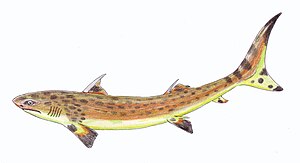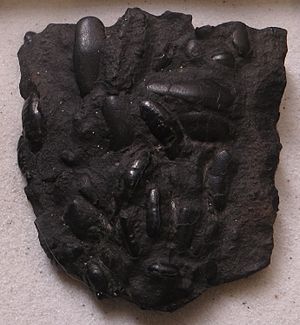Vodnika
| Vodnika | ||||||||||||
|---|---|---|---|---|---|---|---|---|---|---|---|---|

Reconstruction of Vodnika striatula |
||||||||||||
| Temporal occurrence | ||||||||||||
| Wordium to Wuchiapingium | ||||||||||||
| 268 to 252 million years | ||||||||||||
| Locations | ||||||||||||
| Systematics | ||||||||||||
|
||||||||||||
| Scientific name | ||||||||||||
| Vodnika | ||||||||||||
| Munster , 1843 |
Wodnika is an extinct genus of the order Ctenacanthiformes . Thisprimeval shark belongingto the cartilaginous fish (Chondrichthyes)lived from the middle to the upper Permian .
Initial description
Wodnika was first scientifically described by Münster in 1843 - the first description was based on fossil tooth finds in the copper slate from Richelsdorf . However, Münster had already discovered the fossil in 1840.
Taxonomy
The genus Wodnika forms together with the taxa Anaclitacanthus , Amelacanthus , Asteroptychius , Carinacanthus , Ctenacanthus , Cratoselache , Goodrichthys , Pyknotylacanthus and Rhombacanthus the family of the Ctenacanthidae . The latter belongs to the Bandringidae , the Phoebodontidae and the Tamiobatidae of the Euselachier order Ctenacanthiformes. Subtaxa of Wodnika are Wodnika althausi , Wodnika ocoyae, and Wodnika striatula . The type fossil is Wodnika althausi . Münster later discovered the taxon Wodnika striatula at the same site . A new taxon is Wodnika borealis , of which Maisey found the backbone and a dorsal fin in Alaska in 1982 .
features
Wodnika was a small, agile shark that reached a length of a good meter (fossils in Hasbergen, for example, are 50 to 80 centimeters long). It is one of the few Permian cartilaginous fish, of which almost the entire skeleton has been preserved. The animal had a peculiar set of teeth , with the individual teeth being severely flattened, sculpted and, moreover, not covered by any tooth enamel .
The external appearance of vodnika was typical of Ctenacanthiformes: it had two strong, crescent-shaped dorsal fins , in front of each of which a 6 to 10 centimeter long thorn spine protruded , similar to Sphenacanthus . The thorn spines were triangular in cross-section, their back was curved convex and without denticles. There were 7-9 longitudinal grooves or furrows on its surface. The pairs of pectoral and pelvic fins were clearly separated from each other, with a well-developed pectoral and pelvic girdle. The pair of pelvic fins started immediately below the second dorsal fin. The anal fin followed, clearly separated . The caudal fin was externally homocerk . In contrast to Sphenacanthus, the joint of the two strong pectoral fins was not tribasal . The supporting cartilage tissue was missing at the base of the two dorsal fins. In contrast to the taxon Sphenacanthus , with which vodnika shared many characteristics, vodnika was a much more primitive representative of the Ctenacanthidae because of the missing last two characteristics.
Way of life
Wodnika likely a nektischer have been that because of its very robust, flattened, rugosen dentition probably mainly by Hard-learning (such as nautiloid) fed on, very agile swimmers.
Faunal Association
At the Hasbergen site near Osnabrück , Wodnika can be found with other fish such as Acentrophorus , Coelacanthus , Eurysomus , Palaeoniscum and Pygopterus .
Occurrence
The following sites of Wodnika are known:
-
Germany : copper slate , Zechstein Z 1 (Oberperm, Wuchiapingium )
- Dorfitter (quarry belly)
- Hasbergen - 257.3 million years BP
- Kamp-Lintfort , Friedrich-Heinrich colliery
- Lichtenau in the Spessart
- Richelsdorf
- Russia
-
United States :
- Alaska : Siksikpuk Formation (Middle Permian )
The American ichthyologist David Starr Jordan described a single Miocene shark tooth under the name Wodnika ocoyae in his 1919 work Fossil fishes of southern California . In 1923, in his work A Classification of Fishes , he corrects himself and considers the tooth to be only a concretion .
literature
- Giebel, CG: The fish of the prehistoric world, with constant consideration of the living fish. First volume: vertebrates. Third division: fish: i-xii . Brockhaus, Leipzig 1848, p. 1-467 .
- Geinitz, HB: Dyas or the Zechstein formation and the Rothliegende (Permische Formation in part). Book I. The animal remains of the Dyas . Engelmann, Leipzig 1861, p. 130 .
- Weigelt, J .: Important fish remains from the Mansfeld copper slate . In: Leopoldina . tape 6 , 1930, p. 601-624 .
- Schaumberg, G .: Rare examples of presumed sexual dimorphism in the vertebrate fauna of the late Paleozoic . In: Philippia . tape 14 (4) , 2010, p. 289-298 .
Individual evidence
- ↑ G. Münster: Addendum to the description of some strange fish from the copper schist . In: Contributions to the Petrefacten customer . tape 6 , 1843, pp. 47-52 .
- ↑ a b Münster, GG: About some placoids in the copper schist at Richelsdorf . In: Contributions to the Petrefacten customer . tape 3 , 1840, p. 122-126 .
- ^ Robert L. Carroll: Vertebrate Paleontology and Evolution . WH Freeman and Company, New York 1988, ISBN 0-7167-1822-7 .
- ↑ a b Maisey, JG: Studies on the Paleozoic selachian genus Ctenacanthus Agassiz. No. 2, Bythiacanthus St. John and Worthen, Amelacanthus, new genus, Eunemacanthus St. John and Worthen, Sphenacanthus Agassiz, and Wodnika Münster. In: American Museum Novitates . tape 2722 , 1982, pp. 1-24 .
- ↑ a b Cajus Godehard Diedrich: A coelacanthid-rich site at Hasbergen (NW Germany): taphonomy and palaeoenvironment of a first systematic excavation in the Kupferschiefer (Upper Permian, Lopingian) . In: Palaeodiversity and Palaeoenvironments . tape 89 , 2009, p. 67-94 , doi : 10.1007 / s12549-009-0004-6 .
- ↑ a b Schaumberg, G .: Additions to the revision of the Euselachians Wodnika striatula Muenster, 1843 from the Upper Permian copper slate and Marl slate . In: Geol. Palaeont. tape 33 , 1999, pp. 203-217 .
- ↑ a b H. W. Holzapfel and E. Malzahn: The fish remains of the coastal sediments of the lower Zechstein 1 West Germany . In: Geologica et Palaeontologica . tape 18 , 1984, pp. 81-99 .
- ^ MF Glaessner and E. Malzahn: New Crustaceans from the Lower Rhine Zechstein . In: Progress in the geology of Rhineland and Westphalia . tape 6 , 1962, pp. 245-264 .
- ^ R. Schoch and AR Milner: Stereospondyli. Handbook of Paleoherpetology - Encyclopedia of Paleoherpetology . 3B, 2000, p. 1-203 .
- ^ AG Sennikov and VK Golubev: Vyazniki Biotic Assemblage of the Terminal Permian . In: Paleontological Journal . 40 (suppl. 4), 2006, p. S475-S481 .
- ^ DS Jordan and JZ Gilbert: Fossil fishes of southern California (Plate VII, fig. 8) . In: Leland Stanford Junior University Publications, University Series . 1919, p. 13-60 .
- ↑ David Starr Jordan: A Classification of Fishes . Page 95.
